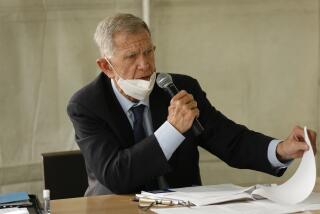Carters Nail Down Housing Issue
- Share via
--Rosalynn and Jimmy Carter, who once occupied a very large white house on Pennsylvania Avenue in Washington, were in the City of Brotherly Love this week helping to restore five abandoned houses in a ghetto neighborhood for Habitat for Humanity, a religiously inspired project to provide decent housing for the poor. The former President and First Lady sweated in 95-degree heat along with about 55 other volunteers, including those who will eventually occupy the houses in a north Philadelphia slum. “It’s a way to put our religious faith into practical use and to meet people who we otherwise wouldn’t get to know,” said Carter, who spent two days nailing up siding. In addition to wielding a hammer, Carter used his powers of persuasion to solicit financial support for Habitat from Philadelphia bankers, businessmen and churches. Millard Fuller, a millionaire lawyer from Americus, Ga., founded Habitat for Humanity 12 years ago. The houses are sold at cost, and the owners’ monthly payments go into building more homes.
--The city of Milwaukee is also out to improve the appearance of run-down houses. But when building code inspectors spotted one that needed a paint job, it turned out to be the home of Mayor John Norquist. Norquist, who was elected this spring, conceded he let home improvements lapse because of the pressure of campaigning. The city’s order gives Norquist 60 days to make arrangements for repainting or face a fine of up to $10,000.
--In yet another example of glasnost or openness, the Soviet Union is joining forces with the U.S. National Park Service to restore a historic Russian Orthodox church building in Alaska. The Russian Bishop’s House in Sitka, the former capital of the czar’s Russian Alaska colony, is being restored to the 1843-53 period when it was occupied by Ivan Veniaminov, who became known as Bishop Innocent and whose diocese covered areas on both sides of the North Pacific. “I think the reason the Soviets are being so cooperative is because of the millennium of Christianity in the Soviet Union,” said Leslie Hart, chief of cultural resources for the Alaska region of the park service. “The work here has attracted our attention,” said Aleksei Schenkov, a Soviet specialist in historic architecture, “and we’re prepared to help.” The Soviet advisers were able to correct several mistakes the Americans made in furnishing rooms and in interpreting what went on in different areas of the building, Hart said.
More to Read
Sign up for Essential California
The most important California stories and recommendations in your inbox every morning.
You may occasionally receive promotional content from the Los Angeles Times.













